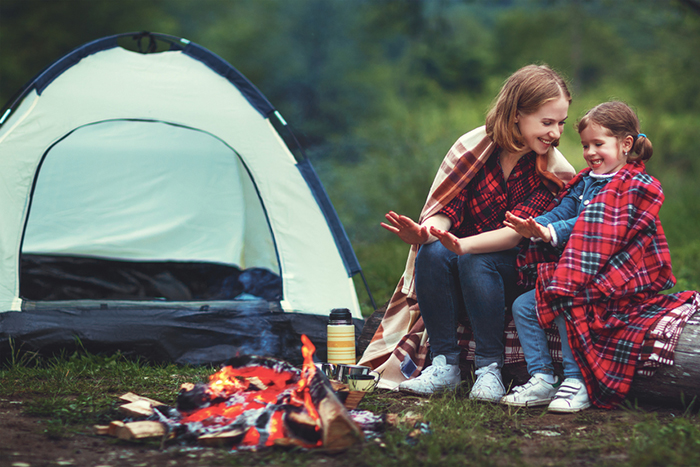
Many of our 2020 summer plans went up in smoke because of the COVID-19 pandemic. We were told to isolate and social distance, which meant vacations and family reunions would have to be postponed. Some people, determined to leave the house in pursuit of alternative leisure, are finding safe and stimulating refuge by camping in the great outdoors. What better way to keep your distance but still have some quality family fun!
When it comes to being fully prepared, seasoned campers are already in the know. But a novice, trying to salvage a bit of summer recreation before the leaves start falling, is likely preoccupied with gathering the basics: tents, backpacks, sleeping bags… all the creature comforts needed for a successful weekend under the stars.
But what about food and cooking? What good is a home run with the gear if you drop the ball when it comes to the meals? Fear not! Even a beginner can pull off a culinary campfire conquest with the right tools and tips. Here are our top 9 pro-hacks – they may just prevent your family from living on potato chips and cold beans.
Burn Before You Cook
Be sure to dig your fire pit at least 10 feet away from your campsite and any tree lines. Use dry wood to reduce the amount of smoke, and keep the fire going for about an hour before you start in with the food. More than the flames themselves, glowing embers provide a nice blanket of heat that is ideal for cooking evenly. You’ll want to burn through a decent amount of wood prior to breaking out your ingredients.
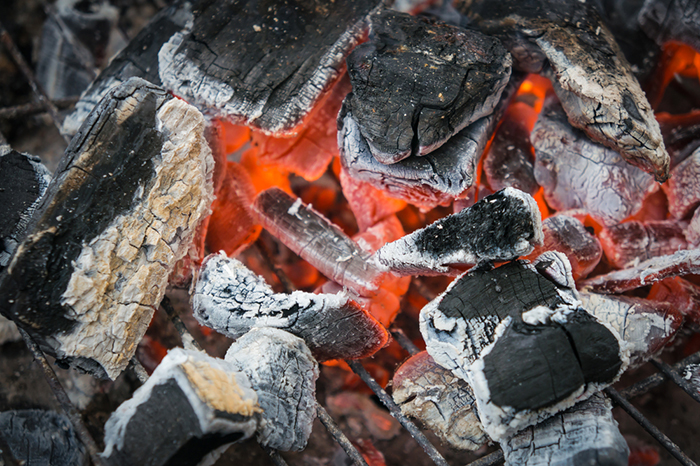
Dough-It-Yourself
Cannisters of ready-made crescent-roll dough offer a wide variety of fun roasting options for parents and kids alike. Twist the dough around the end of a skewer, and hold it over the fire for hot-and-ready bread. Or wrap it around a hot dog for a pig-in-a-blanket that anyone can cook at the end of a stick.
Bring a Grill Grate & Cast-Iron Cookware
We know you want to pack light, but there are certain “must-haves” for campfire cooking. One of these is a grill grate. It’s basically the rack from your home grill, only with legs on either side to elevate it above your fire. Without one, meat may cook unevenly, creating a food-safety issue. You also won’t have a stable, steady surface to hold your cookware in place. The last thing you want is for your casserole to tumble over, extinguishing the fire and ruining dinner.
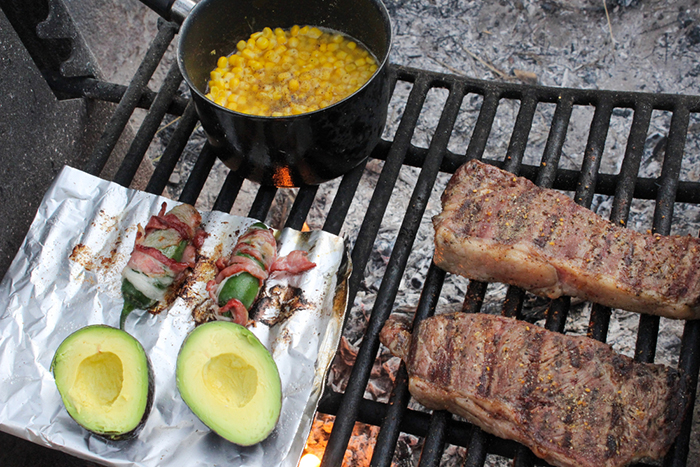
When you’re packing up the car, remember to also bring a cast-iron skillet, pots, and pans. Unlike the fancy, non-stick cookware you may have at home, cast-iron sits right on top of the grilling surface and evenly distributes the heat. You’ll want to pack some fire gloves, and long-handled steel utensils like tongs and spoons. Think long and hard about what you’ll need for your meals, then plan accordingly.
Scramble Ahead
Planning on eggs for breakfast? Make life easy on yourself and do the scrambling at home. Before heading out to the campsite, crack the eggs, mix ‘em up, and store the mixture in the cooler. When you wake up hungry in the forest, simply pour the eggs into your skillet, right from your sealed container of choice. You can use the same hack for pancake batter, but we suggest using a plastic baggie. Snip off one corner, then squeeze the pancake batter out through the hole.
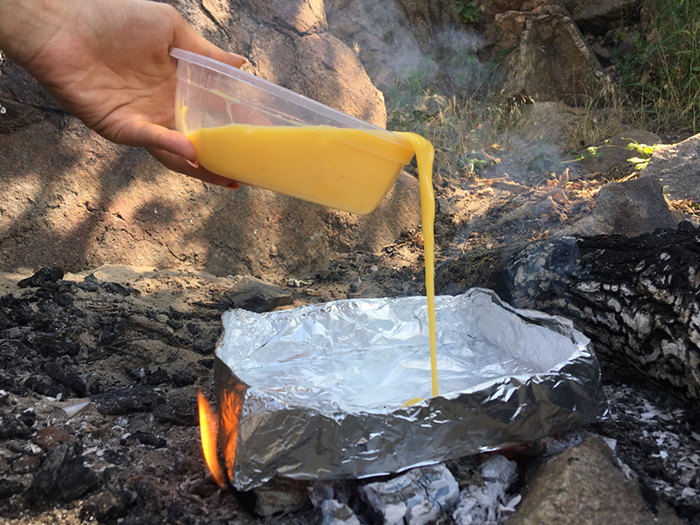
Foil is your Best Friend
Aluminum foil is one of the most important items in a campfire-cook’s bag of tricks. For general use, fish and veggies can be placed in foil pockets for easy cooking directly on the hot coals. Lining your cookware with foil also helps make cleanup a snap. If you forgot the cookware altogether, you can even mold the foil into a makeshift pan!
Can’t set down your soda can because bees keep trying to crawl in? Make a lid out of aluminum foil and jam a straw through it. Nice work, MacGyver.
Real Joe On-The-Go
What morning would be complete without coffee? If you don’t want to use instant coffee while camping, here’s another pre-prep that works like a charm. Before leaving the house, put a scoop of your favorite grounds into a filter, then tie the top closed with dental floss. Use it like a tea bag in some hot water, and enjoy that home-brewed coffee taste while camping.
Orange Peels as Muffin Cups
Cut an orange in half and scoop out the fruit so that just the peels remain, in the shape of half-sphere cups. Fill them with muffin mix or ready-to-bake cinnamon buns, place them in your skillet, and cover it with foil. Check them frequently, and remove when done. Enjoy!
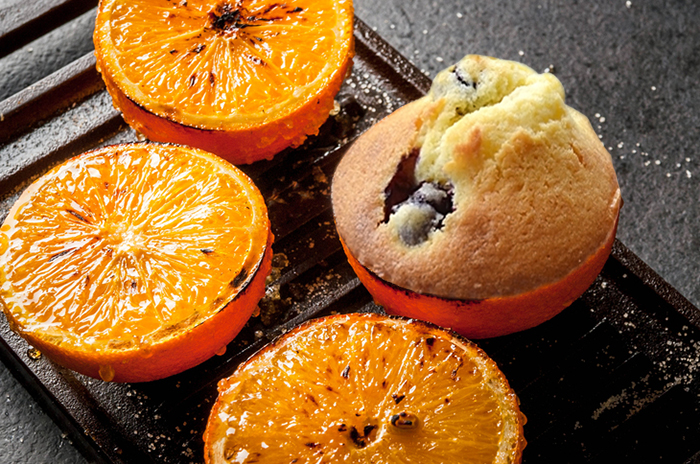
You can also hollow out an apple, fill with trail mix, wrap it in foil, and bake on the embers for another delicious, unique camping snack.
Keep Meat Cold & Use a Thermometer
Prep your meals at home as much as you can, and be sure to keep all of your perishable food in an iced-down cooler until it’s time to cook at the campsite. Use a meat thermometer to ensure safe consumption. Pork, poultry, and burgers are done when the internal temperature reaches 165°F, while steaks and roasts should reach a minimum temperature of 145°F.
Instead of loose ice, consider freezing a couple large jugs of water to store in your cooler. You’ll get a longer chill-time, and still have drinkable water ready to go for the ride home.
Always Finish with Sand and Water
Before you head home, make sure your campfire is properly extinguished. Pour water on the embers and agitate the mixture with a stick. If heat persists, or you hear continued hissing sounds, drown the area again. There’s no such thing as working too hard to make sure your fire is completely out. Once you’re convinced that the water has done its job, pour sand all over the campfire area for an extra layer of security.
Before heading out for your camping trip, be sure to stop in and stock up at your local Pete’s Market. We’ve got all the ingredients for your fireside meals, plus a few extra treats to take your site to the next level.



